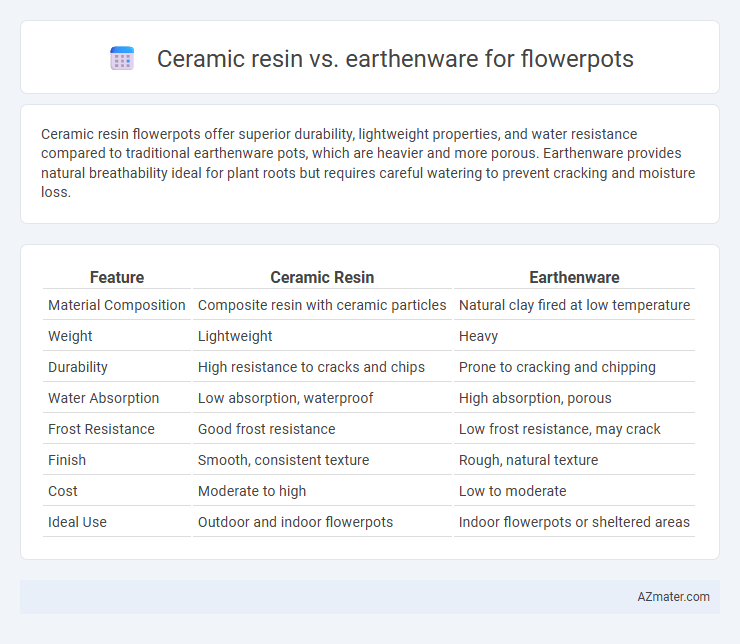Ceramic resin flowerpots offer superior durability, lightweight properties, and water resistance compared to traditional earthenware pots, which are heavier and more porous. Earthenware provides natural breathability ideal for plant roots but requires careful watering to prevent cracking and moisture loss.
Table of Comparison
| Feature | Ceramic Resin | Earthenware |
|---|---|---|
| Material Composition | Composite resin with ceramic particles | Natural clay fired at low temperature |
| Weight | Lightweight | Heavy |
| Durability | High resistance to cracks and chips | Prone to cracking and chipping |
| Water Absorption | Low absorption, waterproof | High absorption, porous |
| Frost Resistance | Good frost resistance | Low frost resistance, may crack |
| Finish | Smooth, consistent texture | Rough, natural texture |
| Cost | Moderate to high | Low to moderate |
| Ideal Use | Outdoor and indoor flowerpots | Indoor flowerpots or sheltered areas |
Introduction to Ceramic Resin and Earthenware Flowerpots
Ceramic resin flowerpots are crafted from a durable composite material that mimics the appearance of traditional ceramics while offering enhanced lightweight and weather-resistant properties. Earthenware flowerpots are made from porous clay fired at lower temperatures, providing natural breathability and moisture regulation for plants. The choice between ceramic resin and earthenware impacts plant health, pot durability, and aesthetic appeal in gardening environments.
Material Composition: What Sets Ceramic Resin Apart from Earthenware
Ceramic resin flowerpots combine natural clay with synthetic resin, enhancing durability, flexibility, and water resistance beyond traditional earthenware's porous, fired clay material. Earthenware, made from natural clay fired at lower temperatures, offers breathability but is prone to chipping and cracking under extreme conditions. The reinforced polymer matrix in ceramic resin imparts lightweight characteristics and resilience, making it ideal for both indoor and outdoor gardening environments.
Durability and Strength: Which Flowerpot Lasts Longer?
Ceramic resin flowerpots offer superior durability and resistance to cracks compared to traditional earthenware due to their composite materials that withstand weather fluctuations and physical impacts. Earthenware pots, while aesthetically pleasing, tend to be more porous and brittle, making them susceptible to chipping and breakage over time, especially in freezing conditions. Therefore, ceramic resin flowerpots typically last longer, providing enhanced strength and longevity for outdoor and indoor gardening.
Aesthetic Appeal: Comparing Design and Finishes
Ceramic resin flowerpots offer a sleek, modern aesthetic with smooth finishes and vibrant color options that resist fading and chipping, enhancing long-term visual appeal. Earthenware pots showcase a rustic, natural charm characterized by their porous texture and earthy tones, which develop a unique patina over time. While ceramic resin excels in uniformity and durability of design, earthenware provides an authentic, handcrafted look favored in traditional and bohemian garden spaces.
Weight and Portability: Ease of Moving Your Flowerpots
Ceramic resin flowerpots are significantly lighter than earthenware, making them much easier to move and reposition around your home or garden. Earthenware pots tend to be heavier and more fragile, posing challenges in portability and increased risk of breakage during transportation. For gardeners prioritizing ease of moving their plants frequently, ceramic resin offers superior lightweight durability and convenience.
Water Retention and Drainage Properties
Ceramic resin flowerpots offer superior water retention due to their non-porous surface, reducing the frequency of watering and promoting consistent soil moisture. Earthenware pots feature a porous, unglazed texture that enhances drainage and aeration, allowing excess water to evaporate and preventing root rot. The choice depends on plant type: moisture-loving plants benefit from ceramic resin's water-holding capabilities, while succulents thrive in the well-drained environment of earthenware.
Suitability for Indoor vs Outdoor Use
Ceramic resin flowerpots offer superior durability and weather resistance, making them highly suitable for both indoor and outdoor use, especially in environments prone to moisture and temperature fluctuations. Earthenware pots, made from porous clay, excel in indoor settings where they provide excellent breathability for plant roots but require more careful handling outdoors due to their susceptibility to cracking in freezing conditions. For outdoor gardens, ceramic resin's low weight and resilience to UV damage make it a more practical choice compared to the traditional, heavier, and more fragile earthenware.
Environmental Impact and Sustainability
Ceramic resin flowerpots, made from synthetic materials, generally have a higher environmental footprint due to the production process involving petrochemicals and lower biodegradability. Earthenware pots, crafted from natural clay, are more sustainable as they are biodegradable, recyclable, and often locally sourced, reducing carbon emissions linked to transportation. The durability and reusability of ceramic resin can improve its sustainability over time, but earthenware's minimal environmental impact and natural composition make it the greener choice for eco-conscious gardening.
Price Comparison: Budgeting for Flowerpots
Ceramic resin flowerpots offer a cost-effective alternative to traditional earthenware, often priced 30-50% lower due to their lightweight and durable synthetic materials. Earthenware pots, crafted from natural clay, tend to be more expensive because of artisanal processes and firing costs, typically ranging from $15 to $50 per pot depending on size and design. Budgeting for flowerpots should consider long-term durability and environmental factors alongside upfront price differences, as ceramic resin provides affordable maintenance while earthenware delivers classic aesthetics.
Choosing the Right Flowerpot: Factors to Consider
Ceramic resin flowerpots offer lightweight durability and resistance to weathering, making them ideal for outdoor and indoor use, while earthenware pots provide natural breathability and moisture control for healthier plant roots. When choosing the right flowerpot, consider factors such as drainage capability, weight for ease of mobility, and compatibility with your plant's watering needs. Earthenware pots tend to dry out faster, suitable for plants requiring well-drained soil, whereas ceramic resin pots retain moisture longer, benefiting species that prefer consistent humidity.

Infographic: Ceramic resin vs Earthenware for Flowerpot
 azmater.com
azmater.com